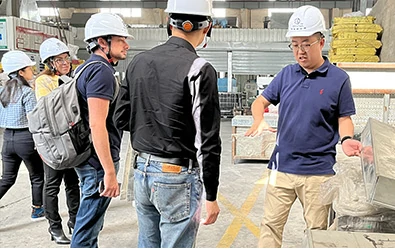loading...
- No. 9, Xingyuan South Street, Dongwaihuan Road, Zaoqiang County, Hengshui, Hebei, China
- admin@zjcomposites.com
- +86 15097380338
- Welcome to visit our website!
Top Manufacturers of FRP Grating Solutions for Various Applications
The Role of FRP Grating Manufacturers in Modern Infrastructure
In the ever-evolving landscape of construction and infrastructure, materials play a crucial role in ensuring safety, durability, and efficiency. One such material that has gained prominence in various applications is Fiber Reinforced Plastic (FRP) grating. As industries continue to seek alternatives to traditional materials like wood, steel, and concrete, FRP grating manufacturers have emerged as key players in providing innovative solutions that meet the demands of modern engineering.
Understanding FRP Grating
FRP grating is composed of a matrix of fiberglass and resin, resulting in a lightweight yet robust product. This composite material has several advantages over conventional grating options. Its corrosion resistance makes it ideal for environments that are exposed to harsh chemicals, including waste treatment facilities, petrochemical plants, and marine applications. Moreover, FRP grating is non-conductive, making it safe for electrical installations and reducing the risk of electrical hazards in industrial settings.
Another significant advantage of FRP grating is its customizable nature. Manufacturers can tailor the design, color, and finish of the grating to match specific requirements, allowing for greater flexibility in design and application. As a result, FRP grating has found its way into a diverse range of sectors, including construction, pharmaceuticals, food processing, and transportation.
The Manufacturing Process
The manufacturing process of FRP grating involves several key steps that ensure a high-quality end product. It starts with the selection of raw materials fiberglass reinforcement and resin, which are combined in specific ratios to achieve desired strength and durability. The mixture is then poured into a mold, where it is cured either at room temperature or under heat, depending on the resin system used.
Once cured, the grating panels undergo rigorous quality control testing. This includes checking for structural integrity, load-bearing capacity, and resistance to environmental factors. Such stringent testing guarantees that the final product meets industry standards and client specifications.
frp grating manufacturer

Many FRP grating manufacturers have adopted advanced technologies such as machine molding and pultrusion. These processes enhance production efficiency and consistency while reducing waste. As a result, manufacturers can offer cost-effective solutions without compromising on performance.
Applications of FRP Grating
The versatility of FRP grating has led to its widespread adoption in various applications. In the industrial sector, it is commonly used for walkways, platforms, stair treads, and access covers. Its lightweight nature makes installation straightforward, reducing labor costs and downtime.
In the marine industry, FRP grating is favored for docks and piers due to its resistance to saltwater and UV degradation. The non-slip surface of FRP grating also contributes to safety in wet environments, minimizing the risk of slips and falls.
In addition to industrial applications, FRP grating is gaining traction in architectural elements, such as façade panels and decorative walkways in parks and public spaces. Its aesthetic appeal, combined with functional benefits, aligns with modern design trends that prioritize sustainability and safety.
Conclusion
As industries continue to evolve, the demand for materials that provide better performance and durability is on the rise. FRP grating manufacturers are at the forefront of this change, offering high-quality, customizable solutions that cater to a broad spectrum of applications. With their expertise in material science and manufacturing processes, these manufacturers are not only meeting the needs of today’s infrastructure but are also paving the way for innovative applications in the future.
The role of FRP grating manufacturers extends far beyond mere production; they are integral to reimagining how we approach construction and safety. By leveraging the unique properties of FRP, they contribute to building structures that are not only functional but also environmentally friendly and sustainable. As we look towards the future, the partnership between manufacturers and industries will play a vital role in shaping the infrastructure landscape, ensuring that it is resilient, efficient, and supportive of modern society's dynamic needs.
-
The Rise of FRP Profiles: Strong, Lightweight, and Built to LastNewsJul.14,2025
-
SMC Panel Tanks: A Modern Water Storage Solution for All EnvironmentsNewsJul.14,2025
-
GRP Grating: A Modern Solution for Safe and Durable Access SystemsNewsJul.14,2025
-
Galvanized Steel Water Tanks: Durable, Reliable, and Ready for UseNewsJul.14,2025
-
FRP Mini Mesh Grating: The Safer, Smarter Flooring SolutionNewsJul.14,2025
-
Exploring FRP Vessels: Durable Solutions for Modern Fluid HandlingNewsJul.14,2025
-
GRP Structures: The Future of Lightweight, High-Performance EngineeringNewsJun.20,2025
